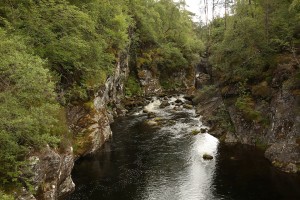
I wrote a blog recently about a day in Glen Affric in early June, when I was suffering from sciatica in my leg, which limited my mobility. Unfortunately, the sciatica got worse after that, so I wasn’t able to make any more trips out to the Caledonian Forest for a couple of weeks. By 6th July, I was feeling somewhat better again, so I decided to return to Glen Affric, with the goal of walking from the Dog Falls area to Coire Loch, to give my leg a gentle work-out, as I’d been encouraged to exercise as part of the recovery process.
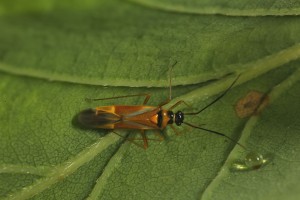
Like that day 4 weeks earlier, I stopped near Badger Falls, where there’s an oak tree (Quercus petraea) growing beside the road, with branches that are just at eye level and easily reachable by hand. Having found lots of invertebrates there before, I wanted to see if the tree was similarly abundant in insects again now. Almost immediately, I found a bug with nice markings on the underside of one of the leaves, which made for a great start to my day of photography.
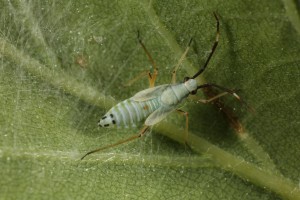
It was only a couple of days later, after I’d sent one of the photos to Joe Botting, the specialist in Hemiptera, that he replied telling me it was an adult of the same species that I’d photographed a nymph of during my earlier trip to Glen Affric in June. In fact, that nymph had been one of several that I’d seen on this oak in June, so this could even be one of those that had metamorphosed into its adult form since my previous visit!
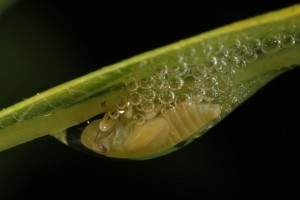
Enthused by this find, I turned over more of the oak’s leaves and soon spotted something else of note. It was a small yellowish shape, surrounded by bubbles of froth on the underside of a leaf. I recognised it as being the developing nymph of the common froghopper (Philaneus spumarius), an abundant and widespread species that is best known for the prolific patches of white froth, or ‘cuckoo spit’ that they produce on vegetation in early summer.
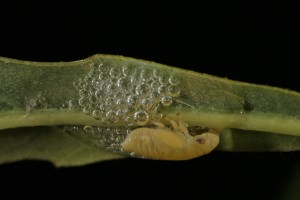
The female froghopper lays her eggs on various plants in the autumn, and when the nymphs emerge in the following spring, they suck the sap of their plant host. They excrete a form of honeydew, and discharge air into this, creating a mass of foam within which the nymph continues to develop, out of sight of, and relatively safe from, predators. The froth also protects the developing nymph from desiccation. In this instance here, the nymph looked like it was almost ready to moult into an adult, which it does without going through a pupal stage – this is known as incomplete metamorphosis.
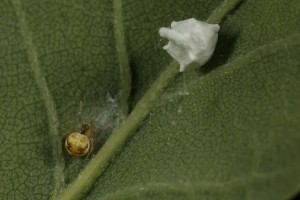
As I continued to look at the oak’s leaves, I came across several tiny spiders sitting on the undersides of them, with an irregularly-shaped white form near to each of them. I recognised these immediately as the egg sacs, with a female spider guarding them while the spiderlings inside developed. I’ve seen these spiders in previous years, but when I checked I discovered that their scientific name has been changed. Formerly known as Theridion pallens, they are now called Paidiscura pallens, as a result of the ongoing work of taxonomists in revising the categorisation of species, often as a result of genetic analysis etc.
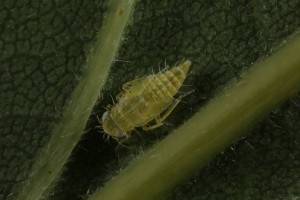
Underneath another leaf, I found something different – a very small insect sitting between the veins, which I recognised as a nymph of a bug in the insect Order Hemiptera. I sent a photo of it, and the specimen itself, to Joe Botting, the Hemiptera specialist who’s done surveys for us at Dundreggan, and he replied that it was a nymph of a bug called Ribautiana scalaris. He was able to identify it to species level only because the adult emerged, in rather poor condition, soon after he received it.
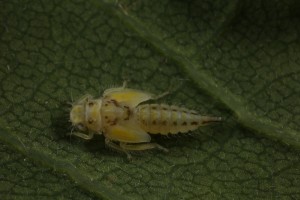
In their nymph stages, many bugs like that cannot be identified to individual species, because the necessary characteristics aren’t displayed until the adult stage is achieved. This was the case for a different nymph that I photographed on the underside of another leaf. I sent the specimen and a photo to Joe, and all he could do was say it was a species in the genus Eurhadina.
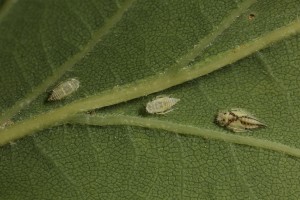
Turning over more leaves revealed quite a few of these bug nymphs, always sitting in between the veins on the underside of the leaves. They are a type of leafhopper, and several species in this genus occur on oaks in the UK. They looked to me like miniature living trilobites, a group of extinct marine arthropods whose fossils are well known. Like other leafhoppers, these ones have specialised mouthparts which are used for sucking the sap from their host, in this case the oak.
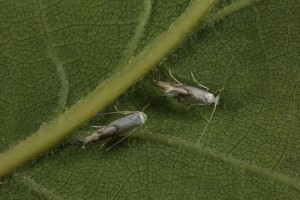
As I continued to turn over more and more of the oak’s leaves, I kept finding different invertebrates underneath them. On one leaf I spotted two micro moths sitting next to each other. Bob Heckford, an expert in micro moths who helps me with identifications, told me they were a species called Phyllonorycter harrisella, which is sometimes known by the common name of white oak midget. The larva of this micro moth feeds on oak, forming a blotch-like mine in the leaves.
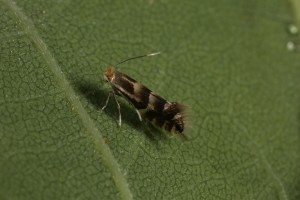
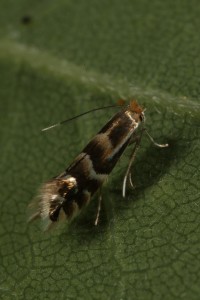
The underside of another leaf revealed a different micro moth, and this one was identified by Bob as being a related species, the red birch midget (Phyllonorycter ulmifoliella). Although its specific scientific name, ulmifoliella, indicates a relationship with elm leaves, the larva of this species does in fact feed on birch trees.
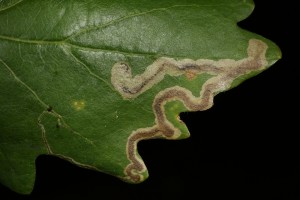
There’s quite a range of micro moths associated with oak trees, and a number of them cause mines in the leaves. This is the phenomenon whereby an adult lays an egg on a leaf, and when the larva hatches out, it eats it way through the structure of the leaf itself, often forming a scribble-like gallery within the layers of the leaf’s structure. I found one of these mines on a leaf on the oak, which is caused by a micro moth, most likely Stigmella ruficapitella – I’m waiting to get this confirmed by an expert in leaf miners.
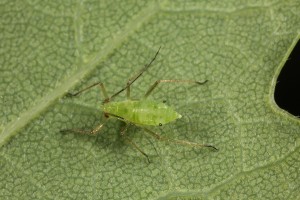
By this time I’d spent quite a while with the oak again, as I did during my previous visit in June, but it was time well spent, as I was finding a lot of interesting life on the tree. Underneath another leaf I found a bright green aphid. Aphids are one of my favourite groups of insects, and I’ve written about them quite extensively in my blogs in the last couple of years.
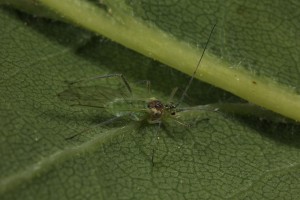
I’m still not able to identify many of them myself though, and in this case I’ve sent the specimen to Ed Baker, a specialist in aphids who did a survey of the group for us on Dundreggan in 2012, for identification. On the underside of a different leaf, I found another aphid, this time with wings. It may actually be of the same species, as aphids have different body forms at different stages of their development, with the winged forms often being necessary to make a definite identification of the species.
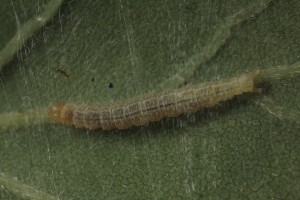
Turning over another leaf, I found a caterpillar lying along one of the leaf veins, underneath a very thin veil of silk strands. I assume that the silk was intended to provide some protection from predators perhaps, by gumming up their mouths when they attempted to take the caterpillar. I’ve subsequently found out that this is the caterpillar of a micro moth, and I’m waiting to hear from Bob Heckford which species it might be.
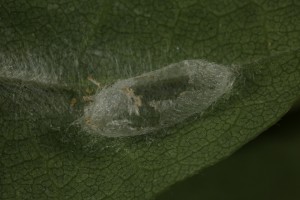
By this time I’d seen quite a few examples of the different stages of development of various insects. The early stages included the nymphs and caterpillars, while I’d also seen adult moths and a bug as well. Underneath a different leaf, I found an example of the pupal stage that comes between the larvae and adults. It was an empty cocoon, within which a transformation would have taken place, and an adult insect would have emerged. It’s impossible to say what insect would have come out of this cocoon, but I was interested to find it nevertheless.
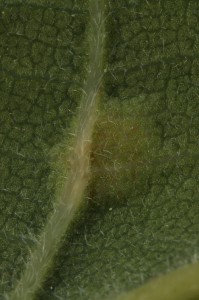
On another leaf, a small swelling on the upper surface drew my attention. It was a gall, induced by a mite (Aceria ilicis), and on the underside there was a small depression filled with hairs, known as an erineum.
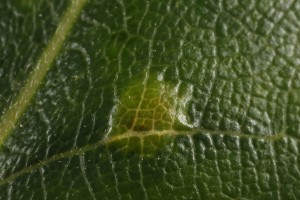
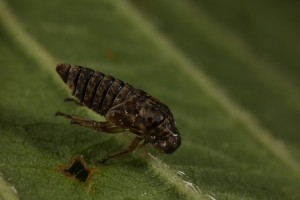
When I’d stopped at this oak tree in early June, I’d also spent some time looking at a young hazel (Corylus avellana) growing nearby, so I took the opportunity of doing so again now. As with the oak, I began turning over some of the leaves, and on the underside of one I found what looked like the cast ‘skin’, or exuvium (as the outgrown exoskeleton of an insect is known as) of a bug. I sent this to Joe Botting as well, and he informed me it was likely to be from a bug called Oncopsis avellanae, but that he’d need an adult to confirm this.
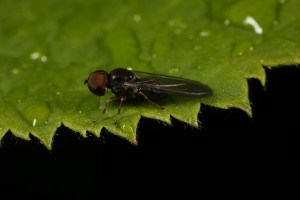
Hazel supports fewer insects than oak does, and this particular hazel was small in comparison to the oak I’d been looking at, so there was less to see and photograph on it. I did manage to get an image of one fly that was resting on a leaf though. As is typical for many flies, it flew away before I could collect it, but I was nevertheless able to get it identified from the photograph as being Cephalops varipes. It is a member of a family of flies that are parasitoids of leafhoppers.
By this time, a couple of hours had gone by, and I’d made very little progress towards my goal of walking to Coire Loch – I hadn’t even reached the beginning of the footpath there, at Dog Falls. I realised also that with the exception of the bug I’d found at the very beginning, all the other invertebrates were different to those I’d seen on my previous visit, in early June. This may be a reflection of what I just happened to find during both visits, but is also due at least in part to the timing of activity by the various groups of insects etc, many of whom have short lives in their adult forms.
I did eventually make it to my destination of Coire Loch in the afternoon, and I’ll continue the rest of the day’s journey in Part 2 of this blog.
Dear Alan
I would like to use one of your pictures: nymph of Philaenus spumarius.
I will use it for one local magazin in Slovenia with your autorisation.
I work as researcher in plant protection in Agricultural institute.
Best regards from Ljubljana, Slovenia
I like your explanations about the life you can find on oaks. I amb a landskeeper amb a garden. I would like to ask you the name of an insect that I found last summer on leaves of oak. I was visiting Irland, an interesting rural garden. There were a lot of them.
It’s possible to contact by my e-mail? Thank you very much and excuse my english.